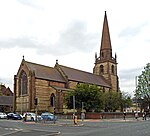City of Liverpool College
The City of Liverpool College is one of three colleges of further education in Liverpool, Merseyside. It was established in 1992 by the amalgamation of all four further education colleges within Liverpool. The College is located over several sites across the city centre. Community-based provision has been disestablished in response to reduction in funding provision by central government. ESOL (English for Speakers of Other Languages) courses are likely to be the sole community-based provision. The college left LEA control and was incorporated in 1993 and is overseen by the Corporation Board. The college's first Principal was Wally Brown CBE. The board is made up of representatives from local businesses and communities. The college receives its funding from the government via the Skills Funding Agency (SFA).
Excerpt from the Wikipedia article City of Liverpool College (License: CC BY-SA 3.0, Authors).City of Liverpool College
Hughenden Road, Liverpool Stoneycroft
Geographical coordinates (GPS) Address Nearby Places Show on map
Geographical coordinates (GPS)
| Latitude | Longitude |
|---|---|
| N 53.426155 ° | E -2.924823 ° |
Address
West Derby School
Hughenden Road
L13 7BP Liverpool, Stoneycroft
England, United Kingdom
Open on Google Maps








